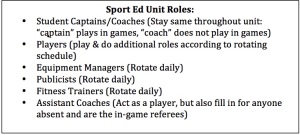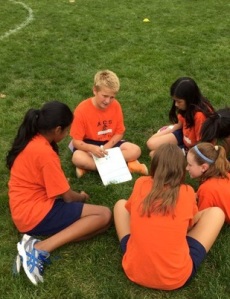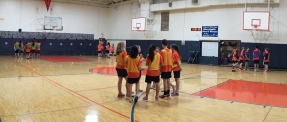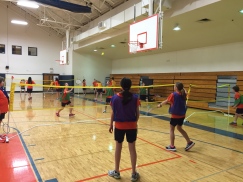The Sport Education instructional model (Sport Ed, SEPEP) is a fantastic way to enhance motivation, engagement, and overall experience of students in physical education. The dynamics of the teacher facilitating the learning experiences, if done correctly, can also be a phenomenal way to address the 4C’s (21st Century Learning: Communication, Collaboration, Critical Thinking, and Creativity) and Common Core Standards and provide enriching experiences for students of all skill levels.
I’ve been using the main ideas from this instructional model in a modified capacity for six years for my middle school classes. I have found that once students have experienced this type of unit (ie: peer-lead activities and the use of teams that stay together through a preseason, regular season, and post season) they overwhelmingly prefer a “Sport Ed” unit over a traditional unit.
While an “event driven” unit can be exciting and memorable, an overcomplicated unit can result in an enormous amount of planning and management; this may lead to teacher burnout and a decrease in student engagement. I have found that adapting some simple ideas from the Sport Ed model can help provide a framework for engaging and repeatable units without an extravagant “dog and pony show.” I have tried several different ways of doing this type of unit, and have found the most success with the basic format below:
Unit Planning:
I usually do 8-12, 30-minute sessions per unit (My school has daily P.E. Each unit spans approximately 3 weeks. We usually do 8 sport units per school year… this can be modified according to your school’s schedule).
- 2-4 sessions of preseason practices
- 3-4 sessions of regular season games (games count toward tournament seeding)
- 3-4 of post season tournament
Middle School Resources:
- Team contract (including fair play agreement)
- Sport specific skill/strategy cards for captains/coaches (Teaching Games for Understanding concepts)

- Posted schedule of jobs/roles for the unit (details below)
- Cognitive assessment (be mindful of the “need to know”
 and the “nice to know” concepts)
and the “nice to know” concepts) - Assessment rubrics for self, peer, and strategy assessment
Routines & Duties:
Students volunteer to be Captain/Coach before the start of the unit. The vast majority
 of volunteers at my school prefer to participate as captains (mainly because they want to participate in the games). Whether or not the student plays games as a captain or coaches from the sidelines, it still allows for an extremely enriching leadership experience.
of volunteers at my school prefer to participate as captains (mainly because they want to participate in the games). Whether or not the student plays games as a captain or coaches from the sidelines, it still allows for an extremely enriching leadership experience.
Team Draft: I use the Team Shake app to “oppose” the captains/coaches and shake up teams (equal ability team configuration). If unfamiliar with Team Shake, I would recommend the teacher creating balanced-ability teams. I usually do 4-5 teams per sport unit. If 2 games are being played, the odd team out will practice off to the side.
Captains/Coaches select an assistant coach who will act as a normal player, but also fill in for the captain/coach if absent. Assistant coach is also the in-game referee (while playing). Assistant coaches must be objective and honest when making any questionable calls in gameplay (rock, paper, scissors is a quick way to solve any disagreements).
Schedule Role Rotation: Rather than having students remain in “non-participant” roles, I have found it more engaging to rotate the roles/jobs throughout the unit to allow maximum participation.
Create and post a spreadsheet with the number of sessions you plan on doing for the unit. Leave the top column of the schedule blank and fill in the date with a pencil on the day of each class.
 Students must check the posted schedule of jobs/roles for each day of the unit to see if they have a job to do that day. This step is extremely important to hold students accountable. If students do not check his/her responsibility for that day, the unit will not run as smoothly.
Students must check the posted schedule of jobs/roles for each day of the unit to see if they have a job to do that day. This step is extremely important to hold students accountable. If students do not check his/her responsibility for that day, the unit will not run as smoothly.
P=Publicist
Last 2 minutes of class, the publicists (one from each team) write 2-3 sentences about what happened today with his/her team (skills/strategies learned, special performances, etc.). Publicists may also snap a few photos if technology is easily available.
F=Fitness Trainer
Lead team through a fitness-based warm-up at the start of class (fitness warm-up task cards optional)
E=Equipment Manager
Sets up and puts away any equipment needed or used that day
C=Coach/Captain
Meets with teacher at the start of class (while fitness trainer is warming up team). Teacher communicates and provides resources for the focus/objectives of the day  (provide guidance to students for how to teach and/or communicate). I use TGfU (Teaching Games for Understanding) concepts and strategies for better transfer of knowledge and a deeper understanding of gameplay. Encourage the use of small-sided modified games in order to teach and practice skills and strategic concepts. Coaches/Captains will almost always have a difficult time on the first day. It is extremely important to let them work through set-backs and failures to figure out their own leadership style. I always debrief with the Coaches/Captains at the end of each class to get their feedback and provide support to help them improve.
(provide guidance to students for how to teach and/or communicate). I use TGfU (Teaching Games for Understanding) concepts and strategies for better transfer of knowledge and a deeper understanding of gameplay. Encourage the use of small-sided modified games in order to teach and practice skills and strategic concepts. Coaches/Captains will almost always have a difficult time on the first day. It is extremely important to let them work through set-backs and failures to figure out their own leadership style. I always debrief with the Coaches/Captains at the end of each class to get their feedback and provide support to help them improve.
Putting together this type of unit can be a daunting task many reasons: worries about giving up control, creating new resources, lack of confidence in student engagement, etc.  The most important bit of advice, in my opinion, is to keep it as simple as possible, especially if you are new to the Sport Ed model. Too often, I see teachers trying to create Sport Ed units with too many jobs/roles and trying to incorporate technology where it may not be needed. Once the teacher and students are comfortable with this type of unit, it becomes much easier to add new enhancements.
The most important bit of advice, in my opinion, is to keep it as simple as possible, especially if you are new to the Sport Ed model. Too often, I see teachers trying to create Sport Ed units with too many jobs/roles and trying to incorporate technology where it may not be needed. Once the teacher and students are comfortable with this type of unit, it becomes much easier to add new enhancements.
Please let me know if you have any questions or additional feedback regarding modified variations of Sport Ed that may enhance student learning experiences in physical education.
Here is a link to my #PhysEdSummit3.0 webinar session for more details:
Here are some examples of resources that I’ve created for various Sport Ed units:
https://drive.google.com/folderview?id=0B0WEidJoxUyKNHlwbzRQQmdqeDA&usp=sharing
Feedback from my students about this Sport Ed unit model:
Pros:
“It enhances cooperative skills. We know each other better and can individualize and assist more directly.”
“The competitive atmosphere is more realistic.”
“Each unit has a purpose and it helps everyone put forth their best effort to improve and help the team.”
“If you don’t know much about the sport, coaching is a great way to learn!”
Cons:
“At times it can become too competitive. For those who are lower skilled, the pressure from certain teammates can become off-putting.”
“Team balance is really important. Mostly the teams are good, but at times gender and ability imbalance can make it difficult”

Great post. I’ve been using the SEPEP model for the last few years in my Year 9 class and it has been an absolute hit. So much so that I am presenting about the unit at an upcoming Physed Conference. Would you mind if I pointed attendee’s towards this post as ‘other places to find out about the model’?
Cheers
James
That’s fantastic! Please feel free to use this blog post as a resource and/or get in touch with me if you questions or things to share that have worked for you. Here is a presentation I just did this morning that may help as well https://youtu.be/boKMSNz94UY?list=PLAvlEo44AU4Wv-IWclFST4KRQwXc3qSdm
I noticed you don’t use referees? Have you tried them before?
Also, do you have the sheets you use for the kids? The contracts? Is there a way I could get them?
Hi Patrick,
I usually do not have permanently assigned referees unless I have students who are injured and want to be referees. I either have the players self officiate or have the assistant coaches sort out any difficult rule decisions. Here is a link to some resources, including contracts: https://drive.google.com/folderview?id=0B0WEidJoxUyKNHlwbzRQQmdqeDA&usp=drive_web
Great blog post. Very useful resources to use in creating a unit, thank you for sharing. Going to role this out to 2-3 classes of mine next term. Would you suggest a lesson 0 with the group or do you try and get into it straight away?
Thanks
Jon
Thanks for the kinds words! If your students have never done this type of unit model before, you should definitely start with a lesson describing the purpose and expectations of the unit. I always describe the Sport Ed model as a privilege to the students; something that they’ve earned the right to be a part of. The better informed the students are about their responsibilities, the better and more realistic the learning experience will be.